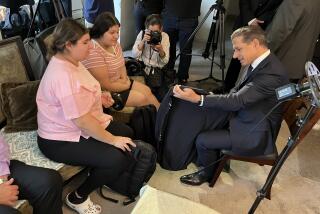Physicians Warn About ‘Parental Fever Phobia’
- Share via
Pediatricians have some new advice for every parent who has ever called a doctor in panic at the first signs of fever in a child--even a fever as high as 104 degrees, provided it is not accompanied by other major symptoms.
The advice is: Take a deep breath. Control yourself. Don’t panic. And if the last part of it sounds a little overly dramatic, doctors say it doesn’t overstate the case at all, given their experiences with parents of feverish youngsters.
Resistance to Infection
The truth is that most fevers in children can be left untreated and require little, if any, attention, doctors say. In fact, medical science is slowly confirming that fever itself may be an important--if previously unrecognized--part of the body’s natural way of battling infection.
But the problem is, say doctors in Canada and the United States, that today’s parents are increasingly allowing themselves to panic at the first signs of fever in their children.
The result is that parents are scaring themselves and their youngsters, medicines are being given and physicians roused from their beds unnecessarily--all because of what doctors have come to call “parental fever phobia.”
A Spreading Concern
While that term for the panic reaction to fever was first coined in 1981, doctors now say fever phobias appear to be increasingly common, or at least more noticeable--perhaps as a byproduct of the rising age at which women are choosing to have babies and the growing number of children being born into the households of young professionals. It is part, these doctors agree, of what has been facetiously called the yuppie baby boomlet.
The phobia term was originated by Dr. Barton D. Schmitt, associate professor of pediatrics at the University of Colorado Medical Center in Denver, who noted undue worry among parents of feverish children and urged better efforts to educate parents about the myths and realities of all sorts of temperatures above normal.
In a telephone interview, Schmitt said that while there is some risk associated with the treatment of fever--even with comparatively innocuous drugs like Tylenol--a potentially more serious problem is the transfer of anxiety and fear about the fever from the parent to the child. “I guess part of my concern is what we’re conveying to people,” said Schmitt. “We are telling them that fevers are so dangerous, of themselves, that they have to be treated so vigorously.”
More important, perhaps, said Schmitt, is a series of recent medical studies that have concluded that fever may have a real and significant role in the way the body naturally fights off infection. Elevated body temperatures, he said, are turning out to play a role in stopping the spread of certain viruses, by slowing the spread of the virus at the same time the body’s own protective mechanisms are brought into action by the fever.
Some studies, said Schmitt, have even shown that various antibiotic drugs work either better or more quickly when body temperature is above the 98.6-degree normal level. At some higher temperatures common to fevers, he said, researchers have found drugs work just as well with only one-tenth the dose of antibiotic necessary without a fever.
Though fever phobia was first noticed among poorly educated parents, a team of Canadian physicians writing in the current issue of Pediatrics, a respected journal, says the panic has spread to the best educated, most intelligent parents, too. In fact, the Canadian doctors speculate, it may be worse among yuppie mothers and fathers than any other group.
The panic is instilled in large degree by the myth that fevers are commonly associated with brain damage. That’s seldom true, doctors agreed, especially when the fever is 104 degrees and below.
Moreover, panic over fever represents conditioned behavior that is often exhibited by doctors themselves, not just by unduly frightened parents. “Parents know that a baby or young child has no other way to (tell a parent it is sick) or not many ways,” said Dr. Michael Kramer, a pediatrician at McGill University in Montreal, where the newly published study was conducted among the parents of 202 feverish young children.
“Because of fever’s association with illness and because parents in general feel helpless in the face of illness in children,” he said in a telephone interview from Geneva, Switzerland, where he is on sabbatical working for the World Health Organization, “a fever symptom noted in a child causes far greater concern than the same fever would if the parent noticed in himself or herself.
“These are normal parental instincts.
“There is this myth that modern medicine can do things it really can’t. Sure, we can lower fever, but it gives parents the impression that we’re really doing something about an illness we can’t do much about, really. Parents convince themselves they are doing something for their child but they really aren’t. You end up regarding fever not as a symptom but as the illness itself.”
Kramer added one important caveat: He said that a feverish child with any temperature but who has symptoms of a stiffened neck should be taken to the doctor immediately because of the risk that the stiff neck might be caused by meningitis.
Kramer also said that, as a general rule, any child who is having difficulty breathing at the same time he is feverish and children who are “simply not with it” or behave abnormally should rouse the suspicion and curiosity of his or her parents.
What has made fever phobia such a problem, though, agreed Kramer and other doctors, is the tradition built up in medicine in which all fevers--particularly those in childhood--have become the subject of aggressive treatment, even though fever itself is rarely associated with a serious outcome for the patient.
Even fevers of 104 to 106 degrees, said Kramer and Dr. Ted Lewis, Los Angeles-area head of the American Academy of Pediatrics, are unlikely to inflict any serious harm to a child. Fevers of 101 to 104 degrees are most often completely benign and are symptomatic most often of a minor infection from which the child will recover normally--usually without regard to what is or is not done for him.
Lewis said that today’s parents who are waiting longer to have their first children are particularly difficult subjects to whom to give advice on fevers. He said that is because older parents so often expect that rearing a child will go smoothly because they have made elaborate preparations for the experience.
Too, speculated Lewis, because many of today’s parents are older, they are further removed from their own childhoods and may not remember fevers very well. And they are less likely to have younger brothers and sisters whose counsel and recollection can sometimes lend a valuable perspective to parenting.
Too often, though, parents rush to treat fever. Sometimes, the treatment includes giving aspirin to the child--a step that involves serious risk, itself, since there is convincing evidence of a link between aspirin and the potentially fatal Reye’s Syndrome, a disorder that begins as a flu-like infection but progresses to brain damage and death in 42% of children who contract it.
Even if parents substitute less harmful acetaminophen (commonly sold under the brand name Tylenol), they still are doing something for their child far more likely to benefit the parents--by creating the illusion of having done something to control the illness--than for the fever victim. More to the point in evaluating the ramifications of fever, cautioned Dr. Rosemary Casey, who designed a fever-education program for parents at Children’s Hospital in Philadelphia, is learning to pay close attention to the way a child is behaving.
“It often doesn’t matter what the number is on the thermometer,” Casey said in a telephone interview. “The parent should be concerned about the child’s behavior and there are certain signs that are worrisome.”
“The same thing would obtain at 104, again if they are playful and drinking well.” Schmitt agreed, noting that in a paper he wrote last year summarizing the ways to evaluate and treat fever in children, he concluded that “how sick a child acts is what counts.”
That is not, of course, to say that all fevers are harmless, agreed Lewis, Kramer and Casey. Indeed, if a baby is crying uncontrollably and becomes irritable in paradoxical ways--if it, for instance, screams more loudly when it is picked up--or if the child seems very sick or disoriented, the problem may be potentially serious and require the attention of a doctor even if the temperature is not high.
Even if a child goes into fever-induced convulsions, he or she is in little danger as long as other more serious symptoms are not present. Convulsions can sometimes occur at temperatures of 104 or higher. Though convulsions are frightening to parents, they generally are not serious and are usually free of aftereffects.
Cooling baths and drinking extra cool liquids--good bets are Popsicles and iced drinks--are sometimes effective, but doctors disagree on the temperature at which a parent should consider tepid baths for a child. Clothing can be removed to make the child more comfortable.
In Kramer’s study, 48% of parents perceived temperatures of 100 degrees or less to constitute feverish conditions and 43% thought temperatures of 102 should be subjected to aggressive treatment. Another 15% believed that untreated fevers would, inevitably, continue to rise and more than half believed it would be appropriate to wake up a young child in the middle of the night to give him or her fever-reducing drugs.
“It is concluded that undue fear and overly aggressive treatment of fever are epidemic among parents of infants and young children,” Kramer and his team concluded, “even among the highly educated and well-to-do.”
Kramer, Schmitt, Casey and Lewis had this advice about fevers in children:
--A temperature does not even qualify for consideration as a “fever” unless it is above 100 degrees when taken by mouth or 101 degrees rectally.
--Generally, it is not until a fever reaches 104 degrees that the temperature itself should cause serious concern and not until it gets to at least 106 is there a serious risk of any brain damage. There is convincing evidence, said Schmitt, that a fever should not be considered dangerous until it reaches 107 or 108. He said 105 degrees is the minimum temperature at which a parent should consider a child’s fever to be “high.”
--Though doctors sometimes disagree, physicians generally advise parents to go ahead and treat fever if the temperature is over 101 or 102. If the fever is above 102, it is appropriate to awaken a sleeping child to give medicines.
In addition to those guidelines, Schmitt’s 1984 paper describing ways to deal with childhood fevers, published in a supplement to the journal Pediatrics, suggested parents call a doctor immediately if: a feverish child is less than 2 months told, the fever is greater than 105, the child is crying uncontrollably, the child is difficult to awaken or seems confused or delirious, the child has a seizure of stiff neck or has purple spots on the skin, breathing seems difficult and the child does not feel better when his or her nose is cleared, the child is “acting very sick” or the child has some genetic condition--like sickle-cell disease--that predisposes him or her to serious infection.
Schmitt said parents can appropriately call the doctor during normal office hours, but not on an emergency basis if the feverish youngster is 2 to 4 months old--unless the fever seems due to a DPT (diphtheria, pertussis (whooping cough) and tetanus) vaccine shot, if the fever is between 104 and 105 degrees, if there is burning or pain on urination, if the fever has been present for more than 72 hours, if it went away for 24 hours but then returned or if the child has a history of convulsions.
More to Read
Sign up for Essential California
The most important California stories and recommendations in your inbox every morning.
You may occasionally receive promotional content from the Los Angeles Times.













